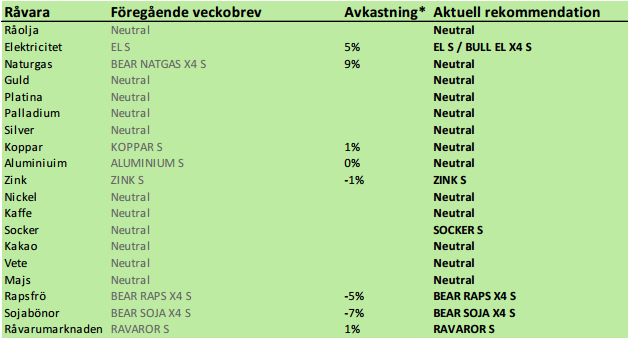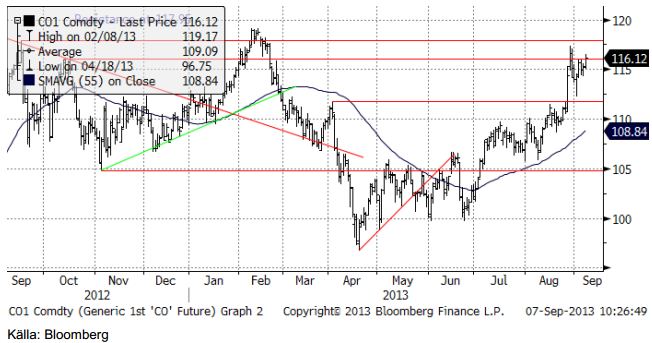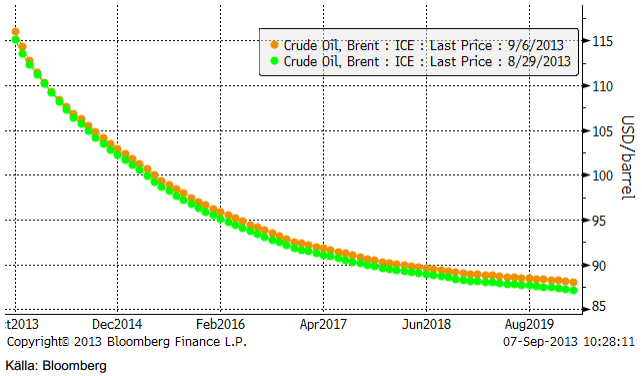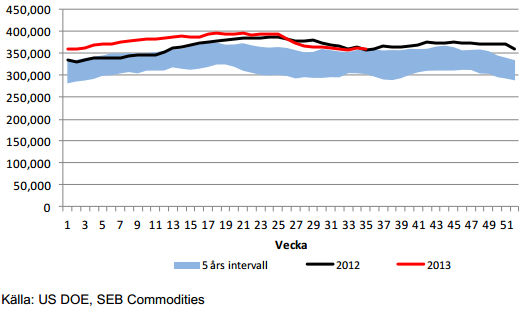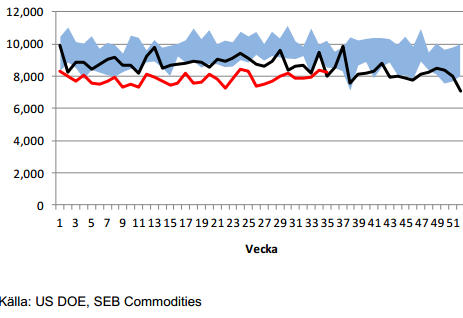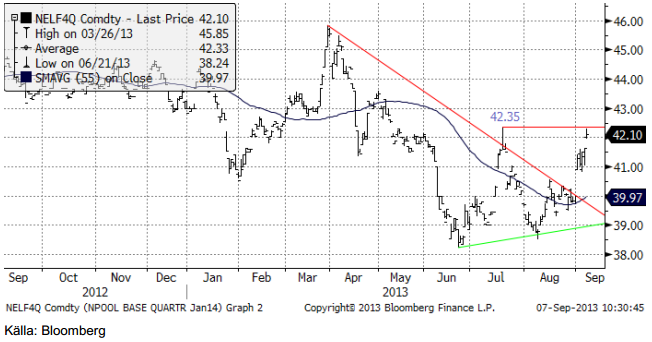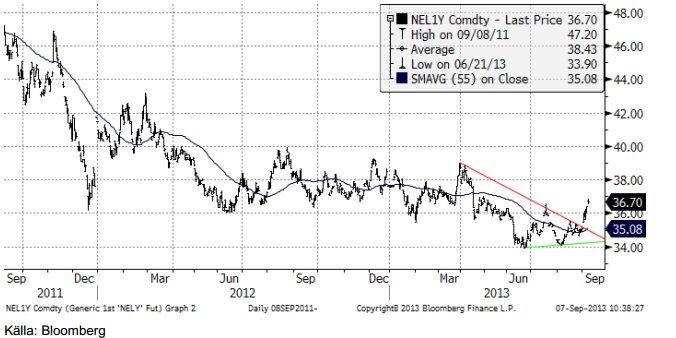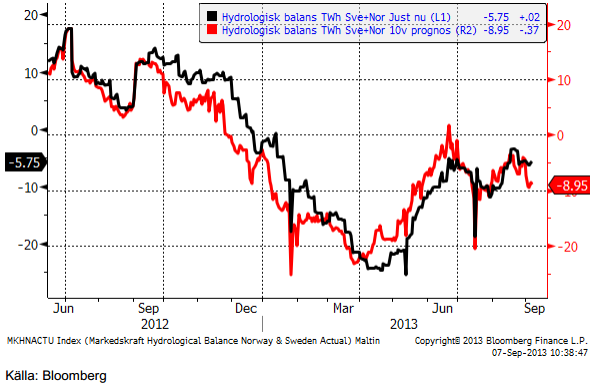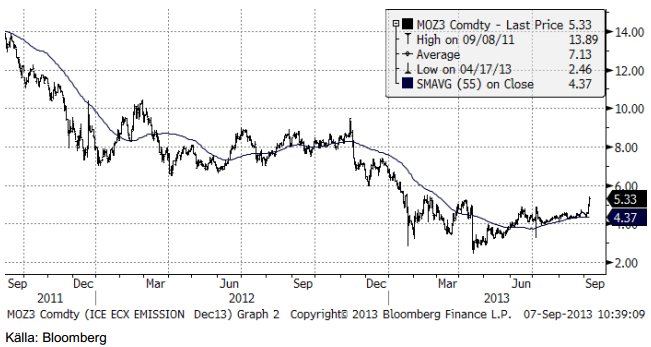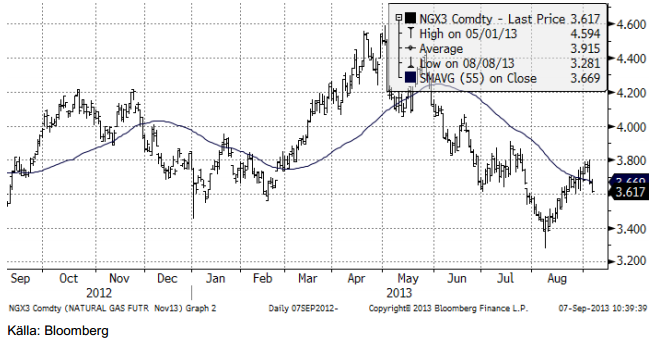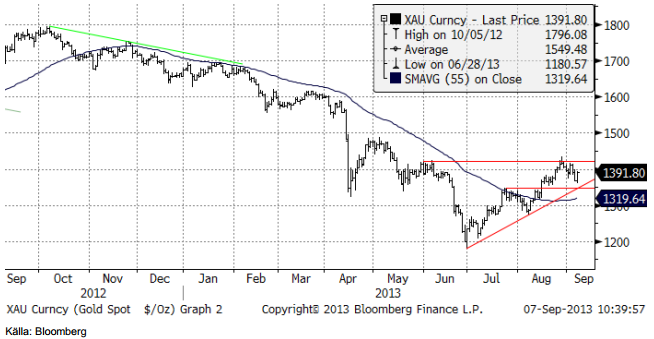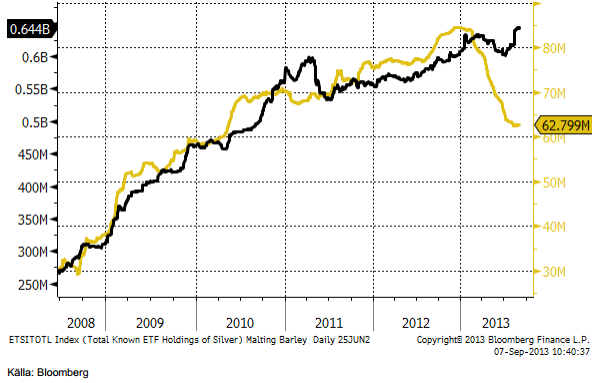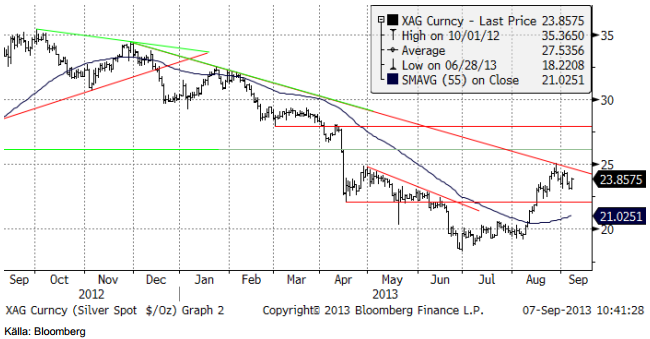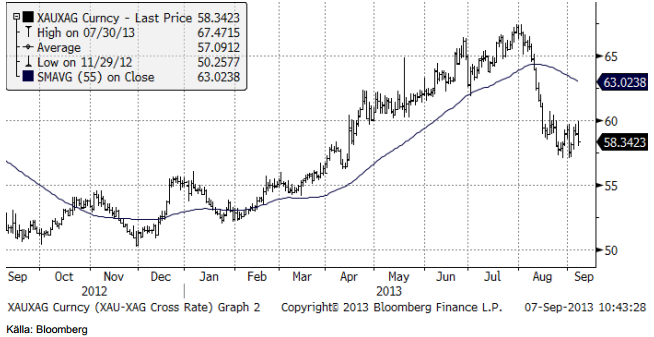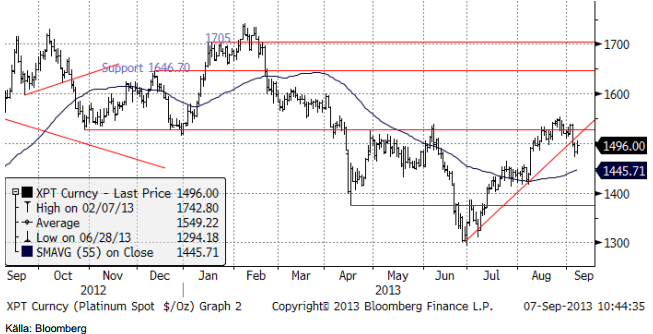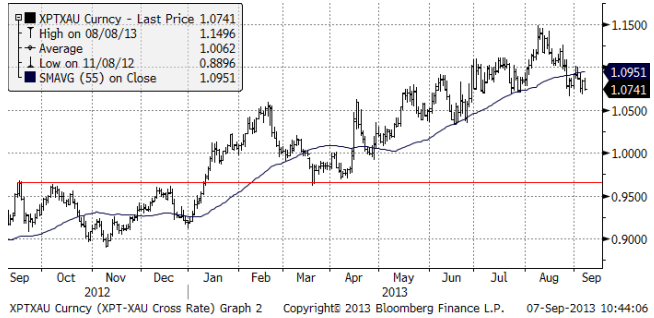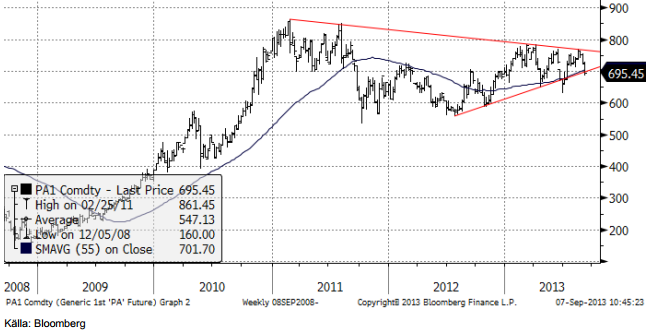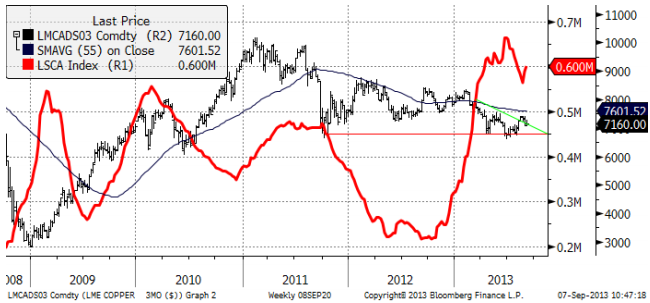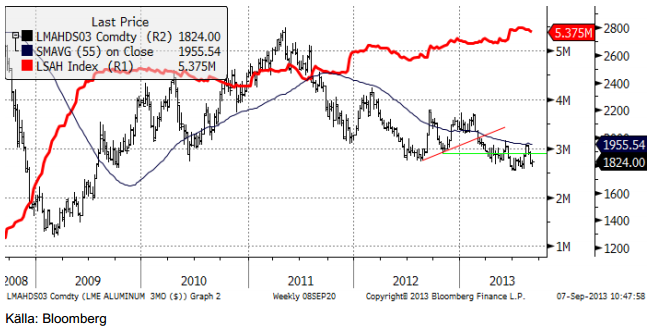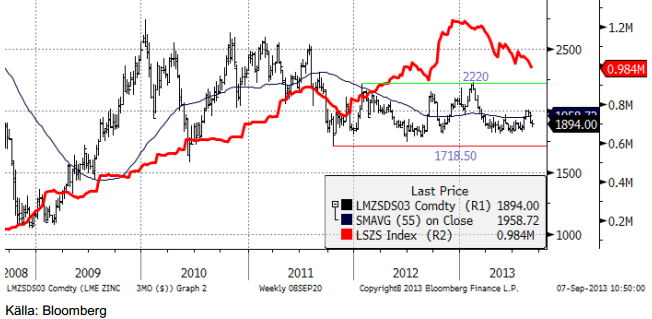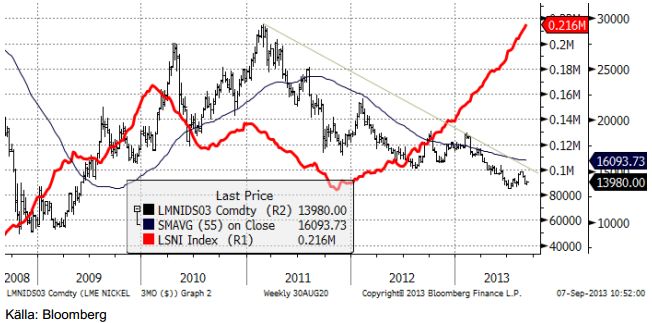Analys
SEB – Råvarukommentarer, 9 september 2013

Rekommendationer
*) Avkastningen lämnar vi blank här eftersom det har varit ett två månaders uppehåll. Generellt sett har dock rekommendationerna varit lyckosamma med kraftiga nedgångar i priset på t ex spannmål och oljeväxter och prisuppgång på basmetaller.
Inledning
Styrkan i elmarknaden förvånar oss inte. En lång position i elpriset är vår främsta rekommendation. Förhoppningsvis får vi en rekyl nedåt i veckan. Det är i så fall ett bra tillfälle att komma in i marknaden till ett bra pris. Det är möjligt att trenden i elpriset kommer att vara uppåtriktad under lång tid.
En annan råvara, som står på gränsen till trendvändning är socker. Produktionen har varit större än konsumtionen i tre år, men nu kommer rapporter om att den här perioden tidigare än väntat är snart är över. Vi rekommenderar därför köp av SOCKER S.
Som ytterligare tecken på att världsekonomin är på väg att återhämta sig kom PMI för UK, Kina och USA in starkare i veckan som gick på 57.2 (54.8), 51 (50.3) och 55.7 (55.4), respektive. Det var alltså mer positiva förväntningar hos inköpscheferna i alla dessa tre länder. Förra veckan kunde vi rapportera att PMI för Eurozonen blev 51.4, vilket ska jämföras med 50.3 månaden innan.
I fredags var dock Non Farm Payrolls-statistiken från USA en besvikelse. Arbetslösheten sjunker visserligen en tiondels procent i USA, men det beror på att långtidsarbetslösa helt enkelt har lämnat arbetsmarknaden. Medan detta kan tolkas negativt, finns också en positiv sida för råvarumarknaden och det är att detta kan få den monetära politiken att vara expansiv längre än den annars varit. Mer pengar som trycks ut i ekonomin under längre tid, pumpar upp latent inflation ännu lite mer.
Råolja – Brent
Oljepriset ligger vid 116 dollar per fat, strax under tekniska motstånd. Fokus är på frågan om USA ska angripa Syrien, men under ytan finns andra faktorer, som driver på. På efterfrågesidan ser vi att USA:s konsumtion av olja växer igen. Implicit efterfrågan är 3% – 4% högre jämfört med förra året och så har det varit de senaste 8 veckorna. USA:s ekonomi håller på att återhämta sig, även om fredagens Non Farm Payrolls var en besvikelse. På utbudssidan ser vi inga tecken alls på att Libyens export komma igång igen.
Den senaste veckan är det framförallt de längre terminskontrakten som har stigit, vad vi i marknaden kallar för ”bakänden”. I diagrammet nedan ser vi hur oljeterminsmarknadens terminspriser ser ut framåt i tiden. Den brandgula kurvan visar hur det såg ut i fredags kväll och den gröna hur det såg ut veckan innan.
Nedan ser vi utvecklingen av råoljelagren i USA.
Importen år 2013 (röd) låg förra veckan på högre än under 2012, för samma vecka. Den ligger dock under snittet för de fem åren dessförinnan.
Ur ett tradingperspektiv skulle jag vilja fortsätta vara neutral. I det korta perspektivet beror prisutvecklingen på USA-Syrien-frågan och den kan vi inte gissa svaret på.
Elektricitet
Nedan ser vi prisdiagrammet på det första kvartalets 2014 kontrakt. Efter vår köprekommendation vid ett pris under 40 euro, har marknaden handlat upp till strax under det tekniska motståndet vid 42.35 euro / MWh. Möjligen kommer en rekyl nedåt och det är i så fall ett köptillfälle.
Det finns de som undrar om de missat tåget, när priserna gått upp så kraftigt. Det har man alls inte gjort. Det är ett klassiskt misstag att inte köpa, bara för att priserna har gått upp kraftigt under kort tid. Priserna har gått ner under 2 år och 8 månader. Pristrenden uppåt kan mycket väl pågå lika länge. Fem dagars hausse innebär inte att det är för sent att ta en lång position i elmarknaden.
När Europa lägger krisen bakom sig återkommer miljöfrågorna förmodligen till agendan. EU-kommissionen beslutade i torsdags att ge ut 12% mindre gratis utsläppsrätter avseende CO2, än vad de som sökt hade hoppats få. Detta reducerar den naturliga långa positionen i marknaden för CO2. Priset på utsläppsrätter teg med 9% under torsdagens handel till ett pris över fem euro. Detta kan utlösa en anstormning för billiga utsläppsrätter. CO2 kan snabbt ta sig upp till 8 euro per ton.
El-terminer för kalenderår 2016 steg med 4% på den tyska elbörsen EEX i torsdags, som en naturlig konsekvens av prisuppgången på utsläppsrätter. Hela terminskurvan är på väg uppåt både på kontinenten och i Norden.
Nedan ser vi spotkontraktet på ”årskontraktet” för el, dvs vad det skulle kosta att prissäkra ett helt kalenderår. Just nu avser spotkontraktet priset för att prissäkra leverans av el under hela år 2014. Diagrammet är på dagsbasis. Även här ser vi att vi har en teknisk köpsignal, då trendlinjen bröts och prist gick förbi toppen i juli.
Vi tror att det är riktigt låga priser på el just nu. Det är orsakat av riktigt låga priser på kol, bottennivåer på utlsläppsrätter och allmän lågkonjunktur. Vi har nu fått en bekräftelse på ”tajmingen” av teknisk analys, vilket stärker oss i uppfattningen om att den nedgång som pågått i 2 år och åtta månader är slut och att en uppgångsfas har inletts.
Hydrologisk balans har fortsatt att försämras, särskilt prognosen.
Marginalkostnaden för att producera el bestäms av priset på kol och priset på utsläppsrätter. Nedan ser vi priset på utsläppsrätter i euro / ton. Notera de kraftiga prisuppgångarna i torsdags och i fredags.
Vi rekommenderar alltså köp av el, t ex EL S eller BULL EL X4 S.
Naturgas
Naturgasprisets rekyl uppåt, vändes i nedgång i torsdags. Priset i fredags stannade på ett tekniskt stöd, 3.60. Vi har ingen vy om vart priset kommer att gå den kommande veckan.
Vi har haft rekommendation av BEAR NATGAS X4 S, men går nu över till neutral rekommendation.
Guld & Silver
Guldpriset rekylerade precis som vi skrev förra veckan, vid det tekniska motståndet. Tekniskt börjar det dra ihop sig till en kamp mellan köpare och säljare. Ovanför dagens kurs finns motståndet från början av juni. Strax under ligger stödlinjen för uppgången som började i juli. Ett brott av någon av dessa, uppåt eller nedåt, ger en anledning att handla.
Nedan ser vi antalet troy uns i ETF:er på silver (svart linje) och i guld (gul linje).
Nedan ser vi kursdiagrammet för silver i dollar per troy ounce. Prisuppgången i veckan stannade vid motståndet på 25 dollar, som nämndes i förrförra veckans brev. Den tekniska bilden är precis som för guld, det står och väger, tämligen jämt mellan ”bulls” och ”bears”.
Nedan ser vi kvoten mellan guldpriset och silverpriset.
Platina & Palladium
Platina har brutit stödet för uppgången från början av juli. Det är inte ett gott tecken.
Nedan ser i kvoten mellan platina och guld. Vi ser att platina börjat handla svagare mot guld. Vi har haft en liten rekyl, men nu skulle platina faktiskt kunna förlora ytterligare mot guldet.
Palladiumpriset är just i färd med att bryta nedåt, ur den triangel vi uppmärksammade förra veckan. Detta kan ge en anledning att gå kort palladium.
Vi är för närvarande neutrala platina och palladium, men om palladium skulle falla bara något lite ytterligare, skulle vi vilja haka på och ta en kort position via BEAR PALLAD X4 S.
Koppar
De som tror på uppgång i kopparpriset pekar på att det ekonomiska läget i Kina håller på att förbättras och de första tecknen på en återhämtning i Europa. De ser detta som en bra anledning att köpa på nedgångar. De som tror på fortsatt nedgång i kopparpriset oroar sig för det ekonomiska hälsotillståndet i tillväxtmarknader som Indien, Brasilien, Ryssland och Indonesien. Effekten av osäkerheten har blivit en högre kursrörlighet. Vi håller mer på den grupp som tror på en uppgång i priset, eftersom fundamenta gradvis tycks förbättras. Vi tror att konsumenter av metallen också kommer att passa på att köpa på prisnedgångar. Å andra sidan hör vi också om producenter som är måna om att hedga om priserna kommer upp till runt 7400 dollar. Det ger oss en ”range” som ligger vid 7000 till 7500 dollar per ton och det är där priset har legat. Skulle priset gå över 7500 dollar, har vi en teknisk köpsignal, men som marknaden ser ut, är det nog en bättre idé att försöka köpa nära botten på prisintervallet, dvs om priset återigen går ner mot 7000 dollar.
Den allmänna uppfattningen i marknaden är att överskottet kommer att bli 408,000 ton nästa år. Det är den högsta nivån på överproduktion i förhållande till konsumtion sedan år 2001. Baserat på en survey av 15 analytiker väntas innevarande år ha en överproduktion på 167,000 ton. Detta är 2% av total produktion. Ökad produktion har varit väntad i flera år. Kinas drag i efterfrågan skulle förr eller senare följas av mer produktion. I takt med att Kinas råvaruefterfrågan planar ut, kommer produktionen i kapp.
Nedan ser vi kopparpriset och lagernivån vid LME. Notera stödet strax under dagens prisnivå och brottet av den nedåtgående kortsiktiga trenden.
Det är en svårtolkad bild och vi rekommenderar neutral position.
Aluminium
Prisuppgången orkade inte igenom 55-dagars glidande medelvärde. Man ser då och då att detta fungerar som ett motstånd, antagligen för att handlare tittar på det och att det attraherar säljordrar när priserna kommer nedifrån upp mot det. Man skulle kunna tänka sig att diagrammet uppvisar en klassisk så kallad ”head and shoulders” formation, med huvudet vid toppen år 2011 och nacklinjen vid 1900 dollar. I så fall är prisobjektivet på nedsidan vid samma bottennivå som i början av år 2009, dvs ca 1300 dollar. Trenden är faktiskt nedåtriktad just nu. Stöd finns vid 1800 dollar. Går priset under den nivån skulle vi vilja vara korta, dvs köpta BEAR ALU X4 S.
Vi har neutral rekommendation, tidigare köp.
Zink
Priset på zink har i nästan två års tid legat inom ett intervall mellan 1718.50 dollar per ton och 2200 dollar per ton, som vi ser nedan. Den röda linjen visar lagren av zink vid LME. Vi ser att marknaden börjat komma mer i balans. De rekordstora lagren har börjat minska.
Vi fortsätter med en försiktig köprekommendation, av ZINK S.
Nickel
Nickelpriset höll sig stabilt i jämförelse med andra basmetaller när marknaden föll i mitten av den gångna veckan. Enligt Macquarie ligger de senaste priserna för Nickel Pig Iron (NPI) med 8 – 13% nickelinnehåll 600 dollar över LME-noteringen. Det är första gången sedan 2012 som detta sker. Just nu är det verkliga nickelinnehållet närmare 15% i NPI, högre än vad det var i juli. I juni låg priset på NPI 2500 dollar under LME-noteringen. Enligt samma källa, kan detta tyda på att utbudet av NPI äntligen håller på att minska.
Detta skulle, åtminstone i teorin, kunna innebära högre pris på nickel. Frågan är om detta är början på en länge efterlängtad förbättring i nickelmarknadens tillstånd. Det kanske är ett tidigt tecken. En blick på lagren och lagerutvecklingen vid LME visar att marknaden har en lång väg tillbaka till balans att gå. Nickel stack ut i veckan som gick och visade förvånande styrka.
Tekniskt har vi ett stöd vid det lägsta priset under år 2013, som är 13,298 dollar / ton. Vi ser också att det finns en motståndslinje från toppen under 2011 som ännu inte är bruten. Än så länge är den tekniska trenden nedåt, men priserna är sannolikt nära botten.
[box]SEB Veckobrev Veckans råvarukommentar är producerat av SEB Merchant Banking och publiceras i samarbete och med tillstånd på Råvarumarknaden.se[/box]
Disclaimer
The information in this document has been compiled by SEB Merchant Banking, a division within Skandinaviska Enskilda Banken AB (publ) (“SEB”).
Opinions contained in this report represent the bank’s present opinion only and are subject to change without notice. All information contained in this report has been compiled in good faith from sources believed to be reliable. However, no representation or warranty, expressed or implied, is made with respect to the completeness or accuracy of its contents and the information is not to be relied upon as authoritative. Anyone considering taking actions based upon the content of this document is urged to base his or her investment decisions upon such investigations as he or she deems necessary. This document is being provided as information only, and no specific actions are being solicited as a result of it; to the extent permitted by law, no liability whatsoever is accepted for any direct or consequential loss arising from use of this document or its contents.
About SEB
SEB is a public company incorporated in Stockholm, Sweden, with limited liability. It is a participant at major Nordic and other European Regulated Markets and Multilateral Trading Facilities (as well as some non-European equivalent markets) for trading in financial instruments, such as markets operated by NASDAQ OMX, NYSE Euronext, London Stock Exchange, Deutsche Börse, Swiss Exchanges, Turquoise and Chi-X. SEB is authorized and regulated by Finansinspektionen in Sweden; it is authorized and subject to limited regulation by the Financial Services Authority for the conduct of designated investment business in the UK, and is subject to the provisions of relevant regulators in all other jurisdictions where SEB conducts operations. SEB Merchant Banking. All rights reserved.
Analys
Tightening fundamentals – bullish inventories from DOE

The latest weekly report from the US DOE showed a substantial drawdown across key petroleum categories, adding more upside potential to the fundamental picture.

Commercial crude inventories (excl. SPR) fell by 5.8 million barrels, bringing total inventories down to 415.1 million barrels. Now sitting 11% below the five-year seasonal norm and placed in the lowest 2015-2022 range (see picture below).
Product inventories also tightened further last week. Gasoline inventories declined by 2.1 million barrels, with reductions seen in both finished gasoline and blending components. Current gasoline levels are about 3% below the five-year average for this time of year.
Among products, the most notable move came in diesel, where inventories dropped by almost 4.1 million barrels, deepening the deficit to around 20% below seasonal norms – continuing to underscore the persistent supply tightness in diesel markets.
The only area of inventory growth was in propane/propylene, which posted a significant 5.1-million-barrel build and now stands 9% above the five-year average.
Total commercial petroleum inventories (crude plus refined products) declined by 4.2 million barrels on the week, reinforcing the overall tightening of US crude and products.


Analys
Bombs to ”ceasefire” in hours – Brent below $70

A classic case of “buy the rumor, sell the news” played out in oil markets, as Brent crude has dropped sharply – down nearly USD 10 per barrel since yesterday evening – following Iran’s retaliatory strike on a U.S. air base in Qatar. The immediate reaction was: “That was it?” The strike followed a carefully calibrated, non-escalatory playbook, avoiding direct threats to energy infrastructure or disruption of shipping through the Strait of Hormuz – thus calming worst-case fears.

After Monday morning’s sharp spike to USD 81.4 per barrel, triggered by the U.S. bombing of Iranian nuclear facilities, oil prices drifted sideways in anticipation of a potential Iranian response. That response came with advance warning and caused limited physical damage. Early this morning, both the U.S. President and Iranian state media announced a ceasefire, effectively placing a lid on the immediate conflict risk – at least for now.
As a result, Brent crude has now fallen by a total of USD 12 from Monday’s peak, currently trading around USD 69 per barrel.
Looking beyond geopolitics, the market will now shift its focus to the upcoming OPEC+ meeting in early July. Saudi Arabia’s decision to increase output earlier this year – despite falling prices – has drawn renewed attention considering recent developments. Some suggest this was a response to U.S. pressure to offset potential Iranian supply losses.
However, consensus is that the move was driven more by internal OPEC+ dynamics. After years of curbing production to support prices, Riyadh had grown frustrated with quota-busting by several members (notably Kazakhstan). With Saudi Arabia cutting up to 2 million barrels per day – roughly 2% of global supply – returns were diminishing, and the risk of losing market share was rising. The production increase is widely seen as an effort to reassert leadership and restore discipline within the group.
That said, the FT recently stated that, the Saudis remain wary of past missteps. In 2018, Riyadh ramped up output at Trump’s request ahead of Iran sanctions, only to see prices collapse when the U.S. granted broad waivers – triggering oversupply. Officials have reportedly made it clear they don’t intend to repeat that mistake.
The recent visit by President Trump to Saudi Arabia, which included agreements on AI, defense, and nuclear cooperation, suggests a broader strategic alignment. This has fueled speculation about a quiet “pump-for-politics” deal behind recent production moves.
Looking ahead, oil prices have now retraced the entire rally sparked by the June 13 Israel–Iran escalation. This retreat provides more political and policy space for both the U.S. and Saudi Arabia. Specifically, it makes it easier for Riyadh to scale back its three recent production hikes of 411,000 barrels each, potentially returning to more moderate increases of 137,000 barrels for August and September.
In short: with no major loss of Iranian supply to the market, OPEC+ – led by Saudi Arabia – no longer needs to compensate for a disruption that hasn’t materialized, especially not to please the U.S. at the cost of its own market strategy. As the Saudis themselves have signaled, they are unlikely to repeat previous mistakes.
Conclusion: With Brent now in the high USD 60s, buying oil looks fundamentally justified. The geopolitical premium has deflated, but tensions between Israel and Iran remain unresolved – and the risk of missteps and renewed escalation still lingers. In fact, even this morning, reports have emerged of renewed missile fire despite the declared “truce.” The path forward may be calmer – but it is far from stable.
Analys
A muted price reaction. Market looks relaxed, but it is still on edge waiting for what Iran will do

Brent crossed the 80-line this morning but quickly fell back assigning limited probability for Iran choosing to close the Strait of Hormuz. Brent traded in a range of USD 70.56 – 79.04/b last week as the market fluctuated between ”Iran wants a deal” and ”US is about to attack Iran”. At the end of the week though, Donald Trump managed to convince markets (and probably also Iran) that he would make a decision within two weeks. I.e. no imminent attack. Previously when when he has talked about ”making a decision within two weeks” he has often ended up doing nothing in the end. The oil market relaxed as a result and the week ended at USD 77.01/b which is just USD 6/b above the year to date average of USD 71/b.

Brent jumped to USD 81.4/b this morning, the highest since mid-January, but then quickly fell back to a current price of USD 78.2/b which is only up 1.5% versus the close on Friday. As such the market is pricing a fairly low probability that Iran will actually close the Strait of Hormuz. Probably because it will hurt Iranian oil exports as well as the global oil market.
It was however all smoke and mirrors. Deception. The US attacked Iran on Saturday. The attack involved 125 warplanes, submarines and surface warships and 14 bunker buster bombs were dropped on Iranian nuclear sites including Fordow, Natanz and Isfahan. In response the Iranian Parliament voted in support of closing the Strait of Hormuz where some 17 mb of crude and products is transported to the global market every day plus significant volumes of LNG. This is however merely an advise to the Supreme leader Ayatollah Ali Khamenei and the Supreme National Security Council which sits with the final and actual decision.
No supply of oil is lost yet. It is about the risk of Iran closing the Strait of Hormuz or not. So far not a single drop of oil supply has been lost to the global market. The price at the moment is all about the assessed risk of loss of supply. Will Iran choose to choke of the Strait of Hormuz or not? That is the big question. It would be painful for US consumers, for Donald Trump’s voter base, for the global economy but also for Iran and its population which relies on oil exports and income from selling oil out of that Strait as well. As such it is not a no-brainer choice for Iran to close the Strait for oil exports. And looking at the il price this morning it is clear that the oil market doesn’t assign a very high probability of it happening. It is however probably well within the capability of Iran to close the Strait off with rockets, mines, air-drones and possibly sea-drones. Just look at how Ukraine has been able to control and damage the Russian Black Sea fleet.
What to do about the highly enriched uranium which has gone missing? While the US and Israel can celebrate their destruction of Iranian nuclear facilities they are also scratching their heads over what to do with the lost Iranian nuclear material. Iran had 408 kg of highly enriched uranium (IAEA). Almost weapons grade. Enough for some 10 nuclear warheads. It seems to have been transported out of Fordow before the attack this weekend.
The market is still on edge. USD 80-something/b seems sensible while we wait. The oil market reaction to this weekend’s events is very muted so far. The market is still on edge awaiting what Iran will do. Because Iran will do something. But what and when? An oil price of 80-something seems like a sensible level until something do happen.
-

 Nyheter4 veckor sedan
Nyheter4 veckor sedanMahvie Minerals växlar spår – satsar fullt ut på guld
-

 Analys4 veckor sedan
Analys4 veckor sedanA muted price reaction. Market looks relaxed, but it is still on edge waiting for what Iran will do
-

 Nyheter3 veckor sedan
Nyheter3 veckor sedanJonas Lindvall är tillbaka med ett nytt oljebolag, Perthro, som ska börsnoteras
-

 Nyheter3 veckor sedan
Nyheter3 veckor sedanOljan, guldet och marknadens oroande tystnad
-

 Nyheter3 veckor sedan
Nyheter3 veckor sedanDomstolen ger klartecken till Lappland Guldprospektering
-

 Analys3 veckor sedan
Analys3 veckor sedanTightening fundamentals – bullish inventories from DOE
-

 Nyheter2 veckor sedan
Nyheter2 veckor sedanRyska staten siktar på att konfiskera en av landets största guldproducenter
-

 Nyheter2 veckor sedan
Nyheter2 veckor sedanSommarvädret styr elpriset i Sverige


